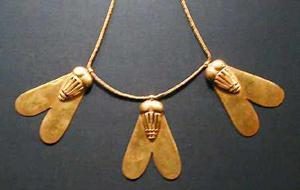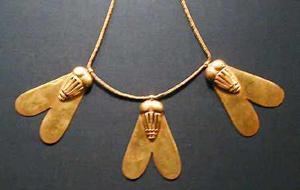The Golden Fly of Valour
by Mennat-Allah El Dorry
Ancient Egypt is the home to many handcrafts. The Ancient Egyptians excelled in metalwork, stonemasonry, sculpture, and jewellery making. Jewellery was one of Ancient Egypt’s most magnificent crafts. It was used for adornment, protection as well as an indication of wealth and social status. Jewellery also was associated with religious activities and musical instruments. Overall, Ancient Egyptian Jewellery not only served as ornamental objects, but it also carried a profound significance.
Of the most famous specimens of jewellery is the “Golden Fly of Valour,” also known as “The Order of the Golden Fly.” It was a fly-shaped pendant, which was mostly made of gold, even though some silver examples have been found.

Fly shaped amulets started appearing as early as the pre-dynastic Naqqada II phase, and the fly was depicted in hieroglyphs as early as then as the sign for “determinator,” and has always been depicted on various ritualistic artefacts throughout the Old and Middle Kingdoms. , such as the so called “magic wand,” (Shaw, Nicholson 1995: 101). Even though the fly started gaining significance and appearing as beads strung on necklaces during the Middle Kingdom, it was not until the New Kingdom when the fly became an important award for military valour (Williams 1924: 61).
Scholars vary on the historical significance of this object. Alix Wilkinson says that even though the Golden Fly of Valour was once awarded for military achievement, it could have been awarded to any courtier (1971: 99-98). Cyril Aldred’s view regarding the significance of the fly is similar to that of Wilkinson. Aldred adds that this object was distributed by the pharaoh on special occasions, such as jubilee, Heb-Seds, and coronation, not necessarily as a military award (1971: 19). An older, yet similar view regarding the significance of this piece is that of Caroline R. Williams’. In 1924, Williams published a book in which she claims that this piece could not have been awarded for military achievement as the most famous examples of the Golden Fly of Valour belonging to a woman, Queen Ah-hotep of the XVIIIth dynasty, and at the time, scholars did not believe women were active in war. Moreover, a necklace carrying 33 small fly pendants was found in the tomb of three of Tutmosis the third’s wives (Williams 1924: 98-99), which the author believes was not theirs, but was their husbands’.
The author thinks that overall, the fly was indeed awarded for military achievement because of its resemblance to the persistence of the enemies. According to the British Dictionary of Ancient Egypt, the fly is the hieroglyphic sign of the word “determinator,” and is the symbol for the sound “aff,” (Shaw, Nicholson 1995: 101). The author assumes that the fly was used as this word, as it is just like the determined enemy, no matter how much it is “shooed” away, it comes back, and one’s exasperation with a bothersome fly is often expressed in a sound similar to “aff”. These have made the author suppose that the fly was associated with the military because of its determinacy as the enemy, as well as the fly’s tendency to hang around battlefields were blood is being shed.
Supporting the argument many scholars put forth, several non-military personnel were depicted wearing the Golden Fly of Valour, as well as the discovery of fly pendants in their tombs. For example, fly pendants were found in the burial place of Senmut, the royal butler of Hatshepsut. One of gold and one of silver were found in his tomb, as well as other representations on the walls. A statue of a man at Tell Edfu was found with fly pendants around his neck. Amongst the royals who owned the flies were XIXth dynasty Queen Tawosret, three wives of Tutmosis III, as well as the most renowned fly pendants from Queen Ah-hotep’s burial at Dra’ Abul Naga.
Flies also appeared in many neighbouring cultures. In Nubia, gold-headed fly amulets were common (Wilkinson 1971:99), and in the Greek Island of Cyprus, examples of fly shaped pendants were found that were imported, probably form Egypt (Williams 1924: 62).
The Shebiu Collar
Similar to the Golden Flies of Valour, the “Order of the Golden Collar”, or the shebiu collar; was part of honorific decoration. The collar consists of up to four rows of thick biconical disc-beads strung tightly together (Wilkinson 112). Gods were not usually shown with shebiu collars, though there is an example of one dating to the new Kingdom shown on a stele (Wilkinson 9).
The shebiu collar first started appearing in the New Kingdom when it was adopted by Tutmosis IV. This tradition lasted throughout the New Kingdom, with many New Kingdom pharaohs being depicted wearing one, or an example was found in their tombs (Wilkinson 1971: 9).
Even though the exact reason for which the collar is awarded remains somewhat unclear, Wilkinson says that this collar was awarded “not only to for military service but also to courtiers whom had rendered distinguished service in civil careers,” (1971:9) This supports the author’s perception of the reason behind this collar because many non-royals were depicted wearing this collar, or it was found in their tombs. Kha’, an architect from the reigns of Amenhotep II and Amenhotep III, owned a shebiu collar. It was definitely his, the author asserts, as it appeared in an X-ray that a shebiu collar was placed around the neck of his mummy (Wilkinson 1966). Moreover, according to Cyril Aldred, these collars were hung around the necks of the people whom the pharaoh desired to honour on special state occasions (1971:18)
The people who have been awarded the shebiu collar, or have been depicted wearing one, or a collar was found in their tomb were mostly of the upper class, some were even pharaohs. A collar was found at a burial at Qurna which belonged to an early XVIIIth dynasty woman. Since the intact burial of this woman included high quality expensive jewellery, she was probably of the royal family, or at least from a very wealthy upper class family (Wilkinson 1971: 94). Another important member of the society who was represented with collars was the high priest of Amun at Karnak, Amenhotep, who was priest during dynasties XVIIIth to XXIIth (Wilkinson 1971: 9). Many New Kingdom pharaohs started wearing the collar after Tutmosis IV made it popular in the XVIIIth dynasty. Amongst them were Amenhotep III, Amenhotep IV (later known as Akhenaten), Ay, and Seti I.
The last pharaoh to be depicted with one was Ramses II. Tutankhamun also had many shebiu collars, most notably were two, one of which was on his inner coffin and another on his mummy mask. (Wilkinson 1971:94). Horemheb was depicted in a limestone relief being decorated before the king. It shows him standing in front of the pharaoh’s kiosk with his arms raised in jubilation, while he is being adorned with many shebiu collars. Ay was also depicted in the same way in another relief (Aldred 1971: 229).
The Menat Necklace
Another important article of jewellery was the menat collar or necklace which first appeared in the Old Kingdom worn by Nebet and Sesheseshet, both priestesses of Hathor. There were two kinds of menat necklaces in Ancient Egypt. The first kind was a collar consisting of many strings of small beads that were collected up and threaded through two or more circular beads. The second type is the same, except for an addition of a single or double “counterpoise.” This sometimes ended narrowly, often with an image of the goddess Hathor depicted on the end. It was also associated with music (Wilkinson 1971: 68).

The exact historical significance of this collar is unknown. It was widely associated with the goddess Hathor, priesthood, music and funerary cults. The first appearance of this collar was from the Old Kingdom worn by two priestesses of Hathor. The Ihwey male dancers, who were associated with Hathor, were also always depicted wearing or holding the collars. The collar was often depicted along with sistra; thus it was probably used as a kind of rattle. Menats were a part of the funerary jewellery represented on the walls of tombs, coffins and funerary stelae, as well as being given to the deceased as a gift. This is mainly because the menats were considered to have the same life-giving properties as an ankh (Wilkinson 1971: 69).
The menat was depicted and has appeared in many different places throughout Ancient Egypt due to the many meanings it evokes. In the XIIth dynasty, King Amenemhat III was depicted wearing a menat collar as a part of a priestly costume he once wore. In the Middle Kingdom, male dancers were illustrated in tombs wearing a menat collar as they performed rituals for the dead. In one depiction, the male dancers held menats in their hands, as well as around their necks, with the accompanying inscription saying that they are offering menats to the goddess Hathor, so she could protect the spirit of the deceased, as well as granting him a long life and demolishing his enemies. Moreover, girls who appeared in the funeral procession of Queen Nofru wore this collar. Menats were also found on female funerary statuettes. Menats were a part of the performance of several rituals. Goddess Hathor performed Sed-jubilee ritual for King Amenemhat III, as well as XVIIIth and XIXth dynasty pharaohs. In the famous literary text of Sinuhe, the daughters of the king who greeted him held out menat necklaces to him. In the new Kingdom, several gods were associated with the menat collars, most notably Khons and Osiris (Wilkinson 1971: 69).
Jewellery obviously played a large part in the development of the Ancient Egyptian Culture, as well as being associated with purposes other than mere decoration. Jewellery was an important Ancient Egyptian element that had many purposes. Ancient Egyptians excelled at jewellery making, often because the jewellery is associated with gods, so the craftsmen fear is they do not do their best they will be punished by the deity whom this piece is dedicated to.
Bibliography
Aldred, Cyril. Jewels of the Pharaohs. London: Thames and Hudson, 1971
Ancient Egyptian Jewellery: Best Selection from the Egyptian Museum. Cairo: Supreme Council of Antiquities, 1999.
Gwinnett, A. John. “Beads, Scarabs, and Amulets: Methods of Manufacture in Ancient Egypt.” Journal of American Research Centre IN Egypt. Egypt, 1993.
Manniche, Lise. Music and Musicians in Ancient Egypt. London: British Museum Press, 1991
The Oxford Dictionary of Ancient Egypt. Cairo: American University Press, 2001
Shaw, Ian and Paul Nicholson. British Museum Dictionary of Ancient Egypt. London: British Museum Press, 1995
Wilkinson, Alix. Ancient Egyptian Jewellery. London: Methuen & Co. Ltd., 1971
Williams, Caroline Ransom. Gold and Silver Jewellery and Related Objects. New York: The New York Historical Society, 1924




